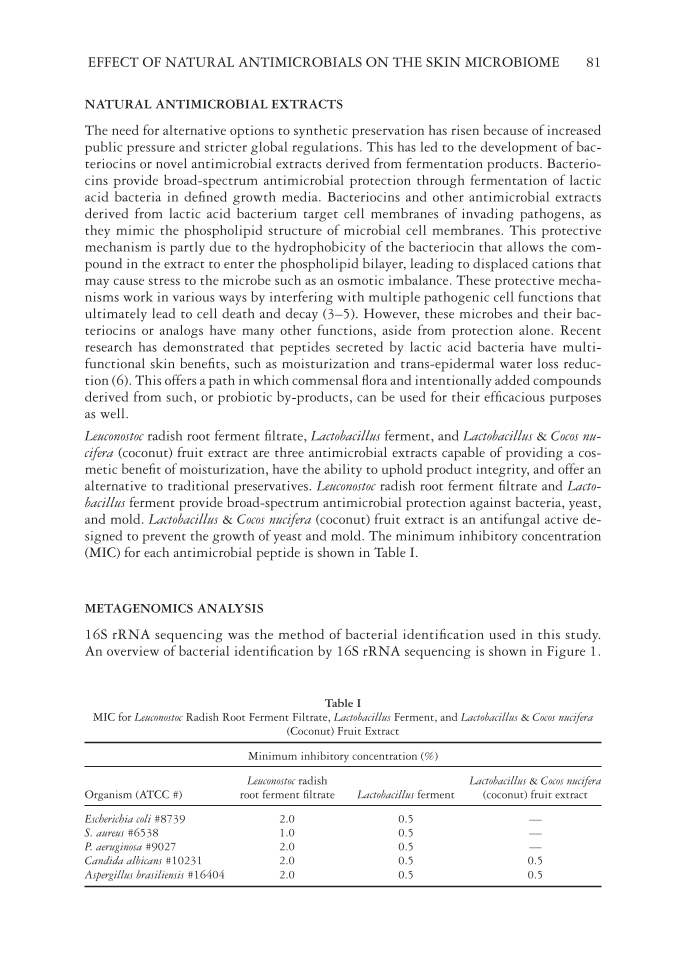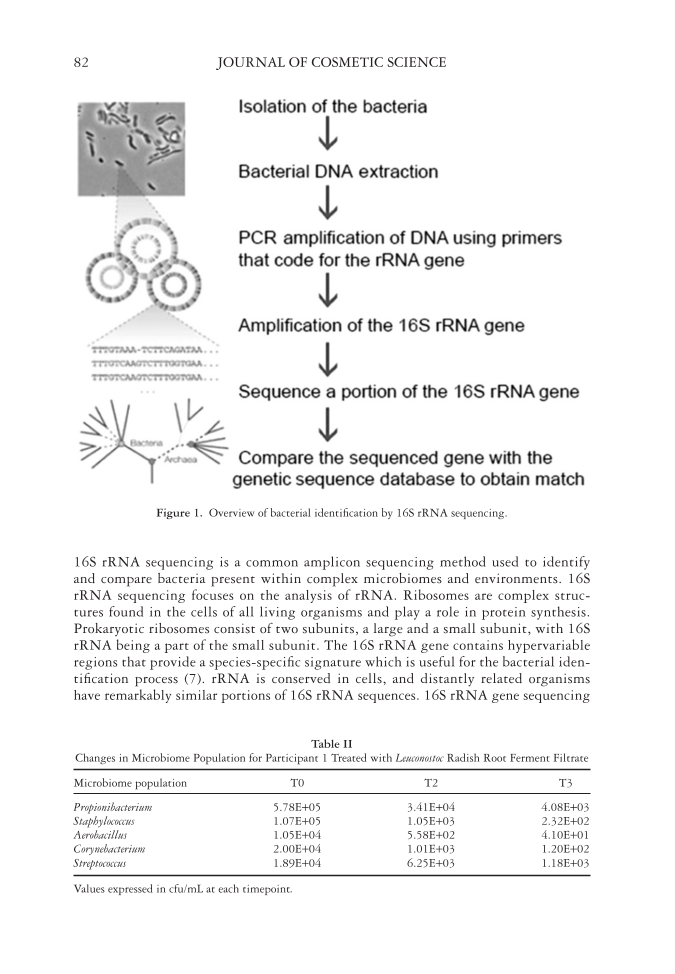EFFECT OF NATURAL ANTIMICROBIALS ON THE SKIN MICROBIOME 81 NATURAL ANTIMICROBIAL EXTRACTS The need for alternative options to synthetic preservation has risen because of increased public pressure and stricter global regulations. This has led to the development of bac- teriocins or novel antimicrobial extracts derived from fermentation products. Bacterio- cins provide broad-spectrum antimicrobial protection through fermentation of lactic acid bacteria in defi ned growth media. Bacteriocins and other antimicrobial extracts derived from lactic acid bacterium target cell membranes of invading pathogens, as they mimic the phospholipid structure of microbial cell membranes. This protective mechanism is partly due to the hydrophobicity of the bacteriocin that allows the com- pound in the extract to enter the phospholipid bilayer, leading to displaced cations that may cause stress to the microbe such as an osmotic imbalance. These protective mecha- nisms work in various ways by interfering with multiple pathogenic cell functions that ultimately lead to cell death and decay (3–5). However, these microbes and their bac- teriocins or analogs have many other functions, aside from protection alone. Recent research has demonstrated that peptides secreted by lactic acid bacteria have multi- functional skin benefi ts, such as moisturization and trans-epidermal water loss reduc- tion (6). This offers a path in which commensal fl ora and intentionally added compounds derived from such, or probiotic by-products, can be used for their effi cacious purposes as well. Leuconostoc radish root ferment fi ltrate, Lactobacillus ferment, and Lactobacillus & Cocos nu- cifera (coconut) fruit extract are three antimicrobial extracts capable of providing a cos- metic benefi t of moisturization, have the ability to uphold product integrity, and offer an alternative to traditional preservatives. Leuconostoc radish root ferment fi ltrate and Lacto- bacillus ferment provide broad-spectrum antimicrobial protection against bacteria, yeast, and mold. Lactobacillus & Cocos nucifera (coconut) fruit extract is an antifungal active de- signed to prevent the growth of yeast and mold. The minimum inhibitory concentration (MIC) for each antimicrobial peptide is shown in Table I. METAGENOMICS ANALYSIS 16S rRNA sequencing was the method of bacterial identifi cation used in this study. An overview of bacterial identifi cation by 16S rRNA sequencing is shown in Figure 1. T able I MIC for Leuconostoc Radish Root Ferment Filtrate, Lactobacillus Ferment, and Lactobacillus & Cocos nucifera (Coconut) Fruit Extract Minimum inhibitory concentration (%) Organism (ATCC #) Leuconostoc radish root ferment fi ltrate Lactobacillus ferment Lactobacillus & Cocos nucifera (coconut) fruit extract Escherichia coli #8739 2.0 0.5 — S. aureus #6538 1.0 0.5 — P. aeruginosa #9027 2.0 0.5 — Candida albicans #10231 2.0 0.5 0.5 Aspergillus brasiliensis #16404 2.0 0.5 0.5
JOURNAL OF COSMETIC SCIENCE 82 Figure 1. Overview of bacterial identifi cation by 16S rRNA sequencing. Table II Changes in Microbiome Population for Participant 1 Treated with Leuconostoc Radish Root Ferment Filtrate Microbiome population T0 T2 T3 Propionibacterium 5.78E+05 3.41E+04 4.08E+03 Staphylococcus 1.07E+05 1.05E+03 2.32E+02 Aerobacillus 1.05E+04 5.58E+02 4.10E+01 Corynebacterium 2.00E+04 1.01E+03 1.20E+02 Streptococcus 1.89E+04 6.25E+03 1.18E+03 Values expressed in cfu/mL at each timepoint. 16S rRNA sequencing is a common amplicon sequencing method used to identify and compare bacteria present within complex microbiomes and environments. 16S rRNA sequencing focuses on the analysis of rRNA. Ribosomes are complex struc- tures found in the cells of all living organisms and play a role in protein synthesis. Prokaryotic ribosomes consist of two subunits, a large and a small subunit, with 16S rRNA being a part of the small subunit. The 16S rRNA gene contains hypervariable regions that provide a species-specifi c signature which is useful for the bacterial iden- tifi cation process (7). rRNA is conserved in cells, and distantly related organisms have remarkably similar portions of 16S rRNA sequences. 16S rRNA gene sequencing
Purchased for the exclusive use of nofirst nolast (unknown) From: SCC Media Library & Resource Center (library.scconline.org)

















































